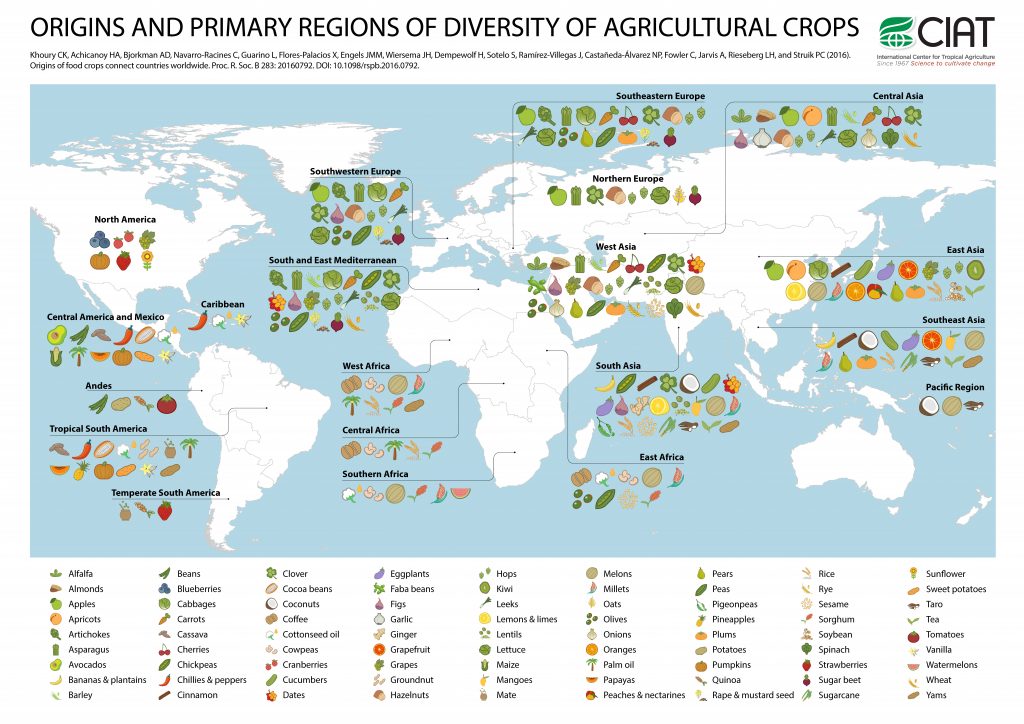Introduction to Crop Wild Relatives
Gayle M. Volk, USDA-ARS National Laboratory for Genetic Resources Preservation, 1111 S. Mason St., Fort Collins, Colorado, 80521 (Gayle.Volk@usda.gov)
Colin Khoury, San Diego Botanic Garden, 300 Quail Gardens Dr., Encinitas, California 92024-2707; International Center for Tropical Agriculture (CIAT), Km 17, Recta Cali-Palmira, Apartado Aéreo 6713, 763537 Cali, Colombia
Stephanie Greene, USDA-ARS National Laboratory for Genetic Resources Preservation, 1111 S. Mason St., Fort Collins, Colorado, 80521
Patrick Byrne, Dept. of Soil and Crop Sciences, Colorado State University, Fort Collins, Colorado 80523
Outline
- Introduction
- Where do food crops come from?
- Vavilov and species diversity
- Why are crop wild relatives important for crop genetic improvement?
- Threats to crop wild relatives
- North American crop wild relatives
- References
- Acknowledgments
1. Introduction
Food production has advanced from the original form where humans gathered food from the wild, to cultivation and selection of wild plants (landraces), and further to modern-day plant breeding of new varieties and cultivars with high quality, yields, and resistance to abiotic and biotic stresses. Food crops have been derived from wild plant species (crop wild relatives) from throughout the world and are now cultivated in locations that may be far from their original sources. Here, we provide information and illustrations about where food crops originated and we highlight the important work of the Russian Geneticist Dr. Nikolai Vavilov, who introduced the concept of “centre of origin” for crop plants and encouraged the conservation and use of crop wild relatives for plant improvement.
Crop wild relatives (CWR) provide genetic diversity that may not be available in current cultivated varieties. The novel genetic diversity within these wild species may be the building blocks that breeders need to improve productivity and quality of agricultural products. Although CWR are likely to be the key to future crop improvements, as wild species, they may be lost if there are shifts in their native habitats. Ex situ genebank collections (maintained under cultivated conditions) provide an opportunity to conserve and protect crop wild relatives for future generations.
2. Where do food crops come from?
Plants have moved around the world for millennia. Species ranges have shifted as a result of geological activity, changing climatic patterns, wind, water, and animal dispersal, and more recently, dissemination by humans. People have often taken the seeds or other propagules of their food, forage, and fiber crops as they migrate to new locations. In modern times, foods grown in one area can be shipped throughout the world within days. In some cases, it may be difficult to guess where food crops originated; however, it’s important to know where food crops and their crop wild relatives came from, particularly when looking for new forms of diversity that may have novelty, disease or pest resistance, or desirable quality and yield traits.
An interactive website has been developed to illustrate the origins of 53 diverse crops: blog.ciat.cgiar.org/origin-of-crops.
 Figure 1. Map showing the origins and primary regions of diversity of agricultural crops is from a publication by Khoury et al. (2016).
Figure 1. Map showing the origins and primary regions of diversity of agricultural crops is from a publication by Khoury et al. (2016).
Video 1. How have crops been transferred among cultures?
3. Vavilov and species diversity
The Russian Scientist Dr. N.I. Vavilov proposed that there are “centres of origin” for cultivated crops around the world where crops and their wild relatives are geographically co-located. These are often the primary locations where domestication took place and Dr. Vavilov proposed that the diversity in these regions could be used to improve crop production. The terms “centers of diversity” and “regions of diversity” are gradually replacing Vavilov’s original “centres of origin” term because in some cases the domestication process may not be co-located with the highest prevalence of its wild species.
 Figure 2. Nikolai Vavilov, Russian botanist and plant explorer. Photo in the public domain.
Figure 2. Nikolai Vavilov, Russian botanist and plant explorer. Photo in the public domain.
Dr. Nikolai Vavilov (1887–1943) was a Russian Agronomist and Geneticist who directed the Lenin All-Union Academy of Agricultural Sciences from 1924 to 1935. In 1924 he coined the term “centers of origin” (now more frequently referred to as “centers of diversity”) for cultivated plants and wrote the “Centres of Origin for Cultivated Plants” in 1926 (Hummer and Hancock, 2015; Janick, 2015). Much of Vavilov’s work is based on that of Alphonse de Candolle (1806-1893) who published the “Origin of Cultivated Plants” in 1882 (de Candolle, 1882). Dr. Vavilov’s explorations led him throughout the world, where he and his staff collected more than 250,000 unique samples of seeds for conservation in the Leningrad Seedbank (which has been renamed as the N.I. Vavilov Institute of Plant Industry, in St. Petersburg). He was sentenced to death in 1941 and his sentence was commuted to 20 years imprisonment. He died of starvation in prison in 1943. Dr. Vavilov is also recognized for developing the Law of Homologous Variation (a particular variation observed in a crop species is also expected to be available in its related species) and for describing the concept of genetic erosion (Hummer and Hancock, 2015).
Dr. Vavilov originally proposed five centers of origin in 1924, then revised it to eight in 1935, and his final papers in 1940 discussed seven major centers (Hummer and Hancock, 2015). Vavilov’s eight described centers are: I. East Asian; II. Hindustani; III. Inter-Asiatic; IV. Caucasian; V. Mediterranean; VI. Abyssinian; VII. Central American; VIII. Andean.
 Figure 3. N. Vavilov’s eight proposed centres of origin, from Vavilov (1992) and Hummer and Hancock (2015).
Figure 3. N. Vavilov’s eight proposed centres of origin, from Vavilov (1992) and Hummer and Hancock (2015).
Video 2. How are Vavilov’s Centers of Origin relevant in modern food systems?
4. Why are crop wild relatives important for crop genetic improvement?
Crop wild relatives contain diversity that is not usually available in established varieties. These crop wild relatives may provide new alleles for resistance to biotic (insects, fungi, bacteria, viruses, or viroids) or abiotic stresses (extreme temperatures, drought/floods, changing weather patterns, etc.), novel flavors and nutrients, and genes that may affect plant architecture, yield, and other traits of interest (Tanksley and McCouch, 1997). Often, the process of genebanking crop wild relatives is more challenging than conserving the cultivated varieties because wild relatives may not be amenable to long-term storage conditions, may be difficult to regenerate (particularly because they have non-uniform maturation times and may shatter), and yields are often lower. It may be advantageous to regenerate seeds of crop wild relatives immediately upon receipt at the genebank to improve their storage longevity.
Video 3. Why is it relevant to conserve crop wild relatives in a genebank?
5. Threats to crop wild relatives
Crop wild relatives may be native to regions or environments that are difficult to protect as a result of changing climates and anthropogenic pressures. Native habitats may be lost due to growing cities, grazing, increased agricultural production, tourism, changes in local environments (dams, depleted water sources, etc), and more (cwrdiversity.org/about/threats). Often, it may not be possible to conserve these native habitats through the creation of protected natural areas. One useful organization that provides information about this subject is The International Union for Conservation of Nature (IUCN; iucn.org), which assesses the status of the natural world. It is important to conserve crop wild relatives in ex situ genebanks as a safeguard against losses that may be encountered by wild populations.
Video 4. Why is there a sense of urgency with regard to conserving crop wild relatives?
6. North American crop wild relatives
North America, including Canada, Mexico and the United States, is rich in wild relatives of globally important major crops, as well as wild cousins of regionally and locally important crops. Areas highest in CWR species include the eastern portion of the United States and southwestern portion of Mexico (Greene et al., 2018b; Greene et al., 2019). Genera with many CWR species in North America include Digitaria, Helianthus, Phaseolus, Prunus, Ribes, Solanum, and Vitis.
 Figure 4. Map showing the number of taxa of crop wild relatives across North America (Greene et al., 2018a).
Figure 4. Map showing the number of taxa of crop wild relatives across North America (Greene et al., 2018a).
North American native CWR have been used for many purposes (Greene et al., 2019). For example, native germplasm was instrumental in developing modern varieties of plum, blueberry and pecan in the United States. Sunflower wild relatives have been used extensively in breeding sunflowers that enable hybrid seed production, and that have disease resistance, salt tolerance, and resistance to herbicides. Wild North American grapevines were instrumental in saving the European wine industry since wine grapes grown on native rootstocks were resistant to Phylloxera, a devastating insect pest.
7. References
de Candolle A. 1882. Origin of Cultivated Plants. New York: Appleton. Retrieved 3/30/2020. Available from: https://archive.org/details/origincultivate03candgoog/page/n11/mode/2up
Greene SL, Khoury CK, Williams KA. 2018a. Wild plant genetic resources in North America: an overview. In: Greene SL, Williams KA, Khoury CK, Kantar MB, Marek LF, (editors). North American Crop Wild Relatives. Volume 1: Conservation Strategies. Springer, New York, NY. p. 3-32.
Greene SL, Williams KA, Khoury CK, Kantar MB, Marek LF. 2018b. North American Crop Wild Relatives. Volume 1: Conservation Strategies. Springer, New York, NY. p. 346.
Greene SL, Williams KA, Khoury CK, Kantar MB, Marek LF. 2019. North American Crop Wild Relatives. Volume 2: Important Species. Springer, New York, NY. p. 740.
Hummer KE, Hancock JF. 2015. Vavilovian centers of plant diversity: Implications and impacts. HortScience 50:780-783.
Janick J. 2015. Nikolai Ivanovich Vavilov: Plant geographer, geneticist, martyr of science. HortScience 50:772-776.
Khoury CK, Achicanoy HA, Bjorkman AD, Navarro-Racines C, Guarino L, Flores-Palacios X, Engels JMM, Wiersema JH, Dempewolf H, Sotelo S, Ramírez-Villegas J, Castañeda-Álvarez NP, Fowler C, Jarvis A, Rieseberg LH, Struik PC. 2016. Origins of food crops connect countries worldwide. Proceedings of the Royal Society B 283:20160792.
Tanksley SD, McCouch SR. 1997. Seed banks and molecular maps: unlocking genetic potential from the wild. Science 277:1063-1066.
Vavilov NI. 1992. Origin and Geography of Cultivated Plants. Dorofeyev VF, (editors), translated by D. Love. Cambridge University Press, UK.
8. Acknowledgments
Citation: Volk GM, Khoury C, Greene S, Byrne P. 2020. Introduction to Crop Wild Relatives. In: Volk GM, Byrne P (Eds.) Crop Wild Relatives and their Use in Plant Breeding. Fort Collins, Colorado: Colorado State University. Date accessed. Available from https://colostate.pressbooks.pub/cropwildrelatives/chapter/introduction-to-crop-wild-relatives/
This training module was made possible in part by funding from USDA-ARS, Colorado State University, IICA-PROCINORTE (procinorte.net), and the United States Agency for International Development (USAID).
Chapter editors: Emma Balunek, Katheryn Chen, Gayle Volk
Videographer: Mike May
This project was funded in part by the National Academy of Sciences (NAS) and USAID, and any opinions, findings, conclusions, or recommendations expressed in such are those of the authors alone, and do not necessarily reflect the views of USAID or NAS.


